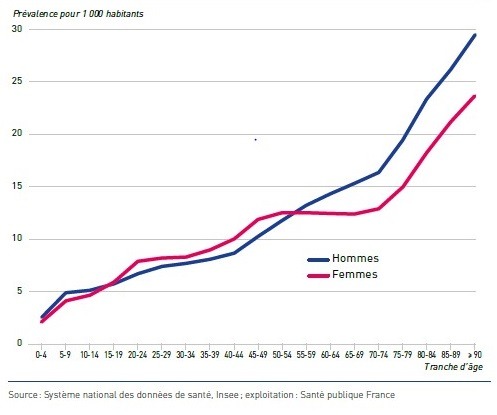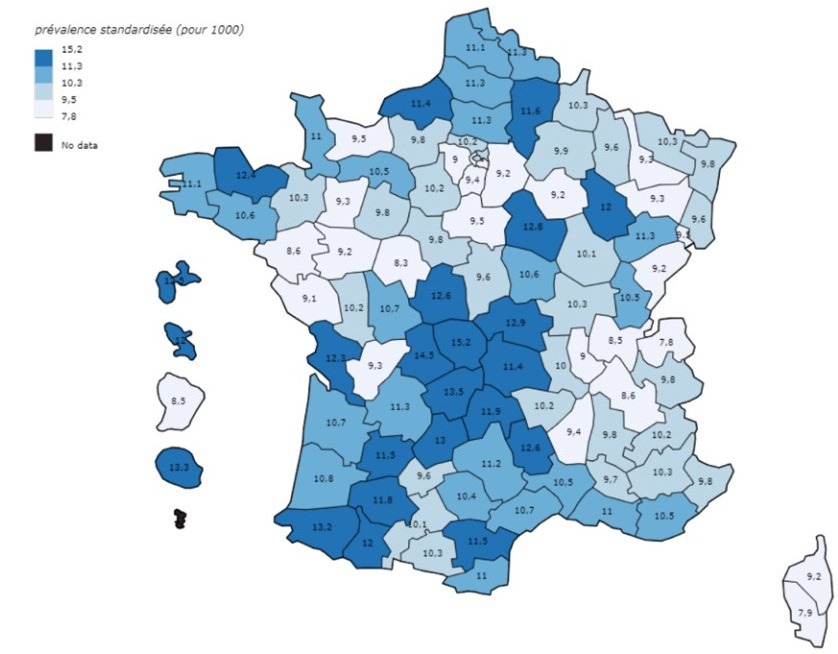Published on
Updated
Reading 3 min.
A study published by Santé Publique France reveals significant social and territorial inequalities regarding the prevalence of epilepsy. Certain departments such as the North and certain Drom are more affected, as well as the most disadvantaged groups.
Public Health France publishes the results of a study on epilepsy treated in 2020 marked by a prevalence similar to those observed in the United States and England and strong social and territorial inequalities.
The 3rd most common neurological disease in France
There is not one but many epilepsies as the forms can vary. However, the disease is characterized by the repeated occurrence of convulsive attacks not provoked by a triggering factor such as head trauma or high fever. This epilepsy, which has a strong personal and social impact, is the 3rd most common neurological disease, behind migraine and dementia.
Despite this frequency, epidemiological knowledge is still imperfect and social and territorial variability is rarely studied. This is why Santé Publique France has conducted an unprecedented study to assess prevalence at the regional and departmental levels over the past 20 years, and one of the rare studies in the world to assess prevalence at the national level.
Based on data from the National Health Data System (SNDS) which compiles approximately 99% of the population, the French study revealed significant social and territorial inequalities.
Nearly 700,000 people with epilepsy treated in France
As of January 1, 2020, 685,122 people with treated epilepsy were identified in France, 41% of whom had been hospitalized and 29% had long-term condition status. The prevalence of treated epilepsy was 10.2 per 1000 inhabitants, identical for men and women. It is similar to that observed in the United States and England (12/1000 in the United States in 2015; 6/1000 in Japan and 9.4/1000 in the United Kingdom).
Prevalence of epilepsy (per 1,000 inhabitants) by sex and age group

In both men and women, the prevalence of epilepsy increases with advancing age. A little earlier in men mainly because of comorbidities, notably cardiovascular, and in particular stroke, which is a cause of epilepsy and occurs earlier in men).
A greater frequency in the North and certain Drom
More surprisingly, the study reveals strong social and territorial inequalities with a concentration of the highest rates in a North-East-South-West diagonal, in the Northern departments, as well as in certain DROMs such as Reunion. Inequalities that Santé Publique France explains “partly by the frequency of associated cardiovascular comorbidities and socio-economic precariousness of these territories“.
Standardized prevalence (per 1,000 inhabitants) of epilepsy by department in France as of January 1, 2020

A 42% higher prevalence among the most disadvantaged
Because the study also shows that the prevalence of epilepsy increases regularly with social disadvantage with a difference of 42% between the most disadvantaged quintile (10.1 cases per 1000 inhabitants) compared to the least disadvantaged (7.1 cases per 1000 inhabitants)!
Beyond the associated comorbidities which could indirectly explain this inequality, Santé Publique puts forward another hypothesis: “The increased incidence of first epileptic seizures observed in socially disadvantaged people could partly be explained by exposure to toxic substances intra utero and during early childhood and to pollution.“.
The consequence or the cause of greater precariousness?
Finally, this social condition can also result from the consequences of the illness and not be the cause: “Likewise, stigma, side effects of epilepsy treatment and associated comorbidities can lead to greater difficulty in finding or keeping a job for sick people or even to a drop in income.“.
According to Santé Publique France, this first study justifies the establishment of new epidemiological surveillance as part of its mission to monitor the state of health of the population.
Read also

